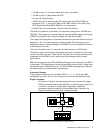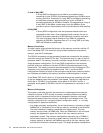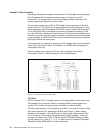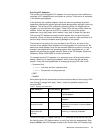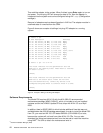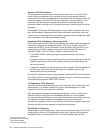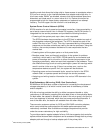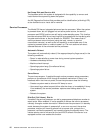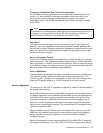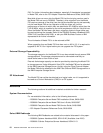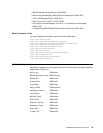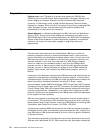IBM RS/6000 7025 Model F80 Server 15
handling mode that allows the bridge chip to
freeze
access to an adapter when a
PCI bus error occurs on the interface between that adapter and bridge chip. In
this frozen mode, DMAs
7
are blocked, stores to that device address space are
discarded, and loads result in a return value of all 1s. Device drivers can be
programmed to look for these dummy responses on loads and can attempt
recovery. The AIX support for this function is not available yet.
System Power Control Network (SPCN)
SPCN consists of a set of power/environmental controllers, interconnected by a
set of serial communication links. In Model F80 systems, the SPCN function is
integrated into the service processor and provides the following functions:
• Powering all the system parts up or down, when requested.
The SPCN hardware has connections to the VPD that is resident on each of
the pluggable cards and the backplane. The VPD is located on each of the
cards in the form of an I
2
C chip. This chip is accessed during initial power on
sequence and the data contents are read by the service processor. Using this
function, the service processor decides not to use components that are
marked
bad.
• Powering down all the system parts on critical power faults
• Monitors power, fans, and thermal conditions in the system for problem
conditions, which result in an EPOW. EPOW stands for environmental and
power off warnings and is a function to inform the service processor or the
operating system early, about an event that happened in the hardware. There
are different warnings; such as cooling warnings or power fail warnings which
result in entries in the error log. If there is a serious error, such as the
temperature reaches a specific limit, the system will be shutdown.
• Reporting power and environmental faults, as well as faults in the SPCN
network itself, on operator panels and through the service processor
• Assigning and writing location information into various VPD elements in the
system.
Disk Redundancy (Mirroring, RAID, Dual Controllers)
RS/6000 and AIX provide a number of options for increasing the robustness of
storage subsystems, all of which involve some level of redundancy of disks
and/or adapters.
AIX disk mirroring provides the ability to define transparent double or triple
redundancy of disk data by mapping disk write data to two or three physical disks.
On disk reads, the request is issued to all disks in the mirror group, and the first
error-free response is returned, which also has some performance benefits. If
one of the disks fails, the data is still readable from the other disk(s).
There are also customer options for SCSI and SSA RAID controller adapters,
which can provide the same protection with better performance and less
redundancy overhead. Also available are storage subsystems that provide
under-the-covers redundancy for high availability.
To provide protection against adapter failures, AIX also supports dual-controller
options where the same disk subsystem can be accessed through both a primary
adapter path and through a backup adapter path if the primary fails.
7
Direct memory access (DMA)



